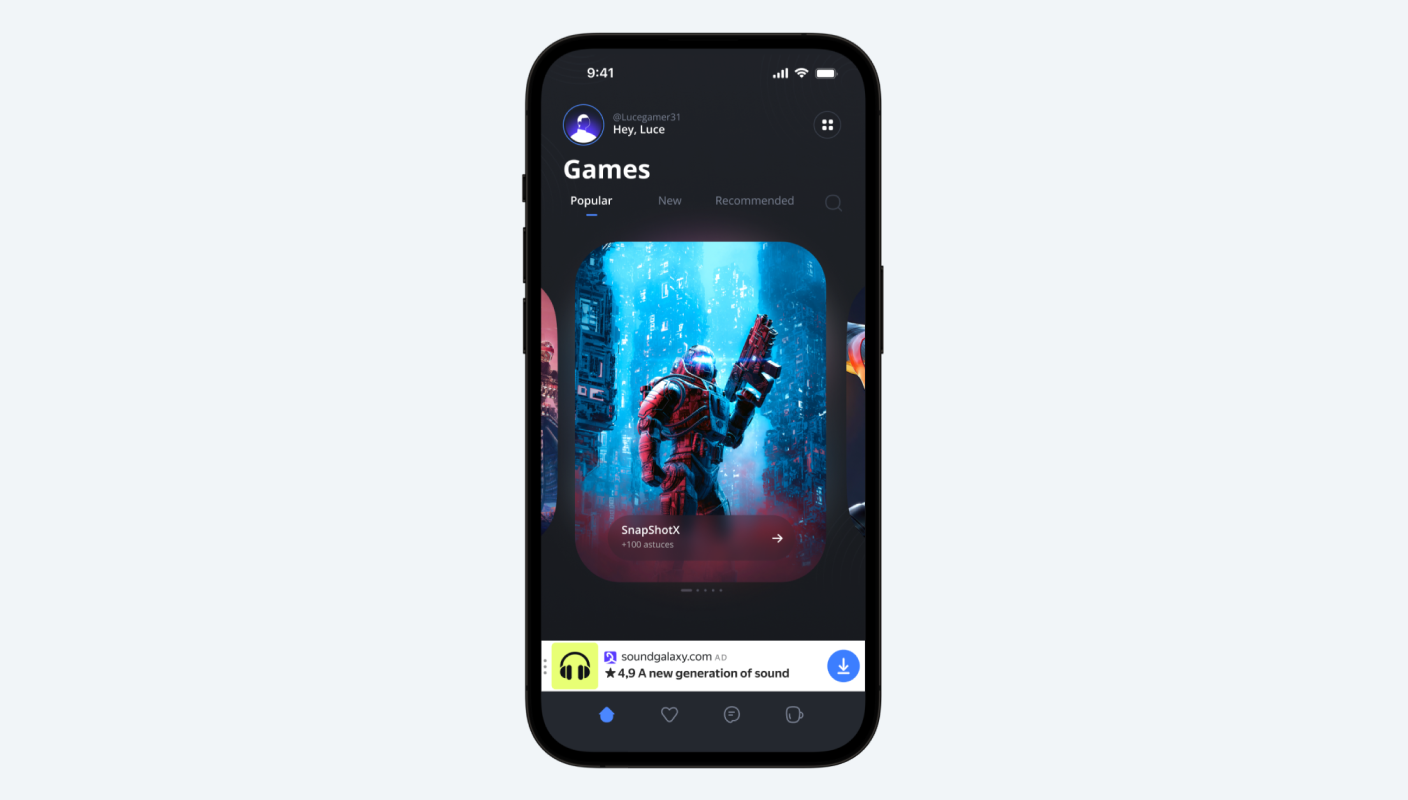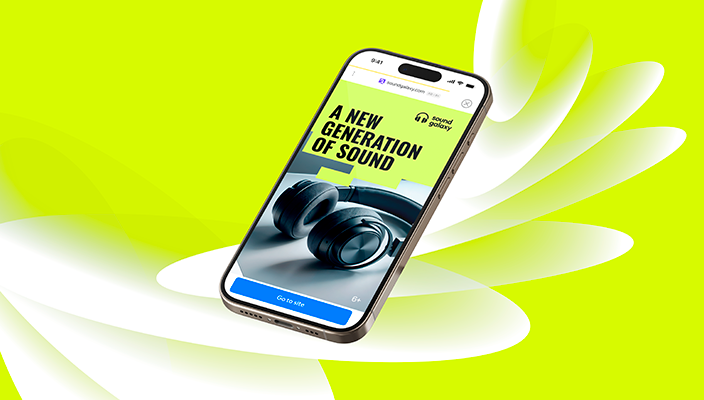Rewarded video ads for mobile apps: implementation & ROI


Your users are tired of forced ads, and your eCPMs show it. Interstitial fatigue is real, driving immediate exits while competitors quietly earn 71% higher ROAS with a format users actually choose.
Unlike interstitials, rewarded video ads offer value instead of interruptions: watch a 15-30 second video, earn in-app currency, unlock premium content, or get exclusive discounts. This voluntary exchange delivers engagement rates 3.5x higher than traditional video formats, with research analyzing over 270,000 consumers showing completion rates above 95% compared to 60-70% for non-rewarded formats. For publishers struggling with declining interstitial performance, rewarded video represents a proven path to sustainable revenue growth without sacrificing user experience.
What are rewarded video ads? Understanding the opt-in model
Rewarded video ads are a mobile ad format where users voluntarily watch short videos in exchange for in-app rewards like virtual currency, premium content, discount coupons, or exclusive features.
Here’s how it works: users see an ad prompt displaying the reward and required action, choose whether to opt in, watch the 15-30 second video if they accept, and immediately receive their promised reward. This value exchange model fundamentally differs from traditional interstitials – users maintain complete control throughout and can decline without penalty.
Today's mobile market demands user acquisition strategies prioritizing lifetime value over installation volume. Rewarded video ads support this shift by creating positive first impressions that encourage retention rather than driving exits. The format has become standard across leading platforms including Yango Ads Ad Network.
The four-step rewarded ad experience
Understanding how users move through rewarded video ads helps you optimize placement and maximize revenue:
Step 1: Ad prompt – Your app displays a clear offer showing exactly what users will earn and what's required. "Watch a 30-second video to earn 50 coins" or "Get 3 extra lives for one video" sets explicit expectations before any commitment.
Step 2: User opt-in – Users make an active choice with complete control. They can accept the offer, decline without consequence, or simply ignore it and continue using your app normally.
Step 3: Video viewing – Once users opt in, they watch the advertiser's video content. Here's what matters for your revenue: users can exit anytime, but they won't receive their reward unless they complete the full video. This creates natural motivation to finish without forced viewing.
Step 4: Reward delivery – Immediately after video completion, users receive their promised reward in your app. This instant gratification reinforces the value exchange and encourages future engagement with rewarded ad opportunities.
The voluntary nature throughout this entire funnel is what drives higher eCPMs. Advertisers know these viewers chose to engage, leading them to bid more aggressively for your inventory than they would for forced placements.
Why rewarded video ads outperform traditional formats
Traditional interstitials are losing their effectiveness, with 90% of mobile users finding targeted ads annoying and actively avoiding them. Rewarded video ads solve this problem by turning advertising into a value exchange, delivering measurable improvements across three critical revenue drivers.
Higher user engagement
Voluntary opt-in creates psychological commitment, driving completion rates above 95% compared to 60-70% for traditional pre-roll ads. Research on interactive mobile advertising analyzing 270,000 consumers found that formats giving users choice increase brand consideration by 36.6%. Users who engage with rewarded video demonstrate 2-3x longer session times, with mobile game publishers reporting peak engagement windows 7-14 days after initial exposure.
Improved user retention
Research from Tapjoy analyzing over 500 million users found that users who watched just one rewarded video during their first week achieved a 30-day retention rate of 53.2% – more than 4x higher than the 12-13% average. Users initially returning for rewards gradually discover your app's organic value, creating a sustainable monetization loop where rewarded video generates immediate revenue while building the engaged user base that supports long-term eCPM growth.
Superior ROAS and revenue performance
Case study data from Survivor Idle Run shows rewarded video monetization achieving 170% global ROAS – 71% higher than traditional video campaigns. Four factors drive this advantage: self-selection filters for genuinely interested users, higher-intent users convert better than passive viewers, retained users generate revenue over months rather than days, and advertisers pay premium rates for opted-in audiences. Industry data shows rewarded video CPM rates running 2-3x higher than standard video ads, with the complete causal chain delivering compound returns that traditional interstitials can't match.

Turn user engagement into premium revenue
Rewarded video ad pricing: CPM, CPI, and CPA models
Three pricing models drive rewarded video monetization, each offering different revenue advantages for publishers.
- CPM (Cost Per Mille) pays per 1,000 impressions served. Current data shows rewarded video eCPMs ranging from $8-20, with US iOS reaching $19.63 in Q4 2024. These rates run 2-3x higher than standard video because advertisers pay premium for 95%+ completion rates.
- CPI (Cost Per Install) pays per app installation, typically $1.50-4.00 depending on geography and vertical. This performance model eliminates waste from uninterested users, ideal for user acquisition campaigns.
- CPA (Cost Per Action) requires specific in-app actions like registration or purchases, paying $3-12+ depending on complexity. This delivers the highest-quality users with proven engagement.
Pricing model comparison
| Model | Payment Trigger | Typical Range | Publisher Revenue Predictability | Advertiser Risk | Best Use Case |
| CPM | 1,000 impressions | $8-20 eCPM (US: $16-20) | High – guaranteed payment per impression | Higher – pays for views, not conversions | Brand awareness, established apps with high traffic |
| CPI | App installation | $1.50-4.00 per install | Medium – depends on conversion rate | Medium – pays only for installs | User acquisition campaigns, performance marketing |
| CPA | Specific in-app action | $3-50 per action | Lower – requires deeper user engagement | Lower – pays only for qualified actions | Quality-focused campaigns, high-LTV apps |
Revenue depends on geography (US/EU highest), app vertical (gaming outperforms), and placement optimization. Typical gaming apps generate $3-8 eCPM from rewarded video, with top implementations exceeding $15 eCPM.
Platform restrictions: iOS and Android considerations
Platform compliance determines whether your rewarded video implementation goes live or gets rejected, making it essential to understand each platform's specific requirements before development begins.
iOS restrictions under Apple's policies
Apple's App Store Review Guidelines explicitly prohibit rewarded ads that manipulate store metrics. You cannot offer rewards for App Store ratings, reviews, or social shares designed to artificially boost rankings. The restriction protects the integrity of Apple's rating system while preserving legitimate rewarded video use cases.
What you can reward: video views, in-app actions, gameplay progression, content unlocks, virtual currency, and premium feature access. What you cannot reward: "Watch this ad to unlock 5-star rating prompt" or "Share on social media for 100 coins" when the share targets App Store manipulation.
The distinction matters. Apple approves rewarded video ads that enhance your app experience through legitimate in-app benefits. They reject implementations that attempt to game their store systems, even indirectly.
Android's approach
Google Play policies take a lighter touch with rewarded video implementations, focusing primarily on transparency rather than restricting specific reward types. The core requirement: clear disclosure that users receive rewards for ad engagement.
Your rewarded ad prompts must state exactly what users will receive and what action they must complete. "Watch a 30-second video to earn 50 coins" passes. A vague "Tap here for free rewards" that hides the ad requirement fails. Google prohibits deceptive practices and forced ads disguised as voluntary engagement, but generally permits broader reward structures than iOS.
Compliance best practices
Three principles ensure platform approval across both iOS and Android. First, provide crystal-clear disclosure showing reward value and required action before users opt in. Second, maintain genuine voluntary engagement with visible decline options that carry no penalties. Third, limit rewards to appropriate in-app benefits like virtual currency, content unlocks, and gameplay advantages rather than store manipulation tactics.
Yango Ads Ad Network maintains full compliance across both platforms through pre-vetted creative and reward mechanics, ensuring your rewarded video implementations meet Apple and Google requirements before launch.
Best app verticals for rewarded video monetization
Not all apps benefit equally from rewarded video monetization. Success depends on usage patterns, session length, content richness, and how naturally rewards integrate into your app's core experience.
Mobile games: the ideal fit
Mobile gaming represents the perfect environment for rewarded video monetization. Virtual rewards integrate seamlessly into game economies where players already understand the value exchange between time and resources.
Longer session lengths allow multiple ad opportunities, progression systems create demand for rewarded resources, and voluntary engagement aligns with gaming's entertainment model. Implementation varies by genre: puzzle games offer extra lives, RPGs provide premium currency for gacha pulls, and casual games grant ad-free sessions.
Gaming apps in the US achieve eCPMs of $11-20 (iOS $19.63, Android $16.49 in Q4 2024), with completion rates exceeding 95%. Industry research shows 78% of mobile gamers willingly watch rewarded video for in-game benefits.
Finance, entertainment, and lifestyle apps
Content-rich apps with repeated usage patterns also benefit from rewarded video monetization, though not as strongly as gaming.
- Entertainment apps like music streaming services successfully implement ad-supported models. Spotify uses ads as part of its freemium monetization, showing ads between tracks to free-tier users who can then choose between continued ad-supported access or upgrading to Spotify Premium for an ad-free experience.
- Entertainment apps like music streaming provide ad-free listening sessions or content unlocks for video views, appealing to users unwilling to pay for premium subscriptions.
- Lifestyle apps including fitness trackers and productivity tools reward video engagement with premium workout unlocks or advanced feature access.
The key differentiator: these apps must have frequent usage patterns that create ongoing reward opportunities. Users returning multiple times weekly find sustained value in rewarded video options.
Poor fit scenarios
Quick-interaction utility apps represent poor fits for rewarded video monetization. Calendar apps, weather checkers, and calculators serve users who open for specific tasks, complete them in seconds, and exit immediately.
A 15-30 second video requirement disrupts these workflows entirely. Users checking tomorrow's temperature won't watch ads for features they don't need. No natural reward integration opportunity exists when the core use case takes less time than the video itself.
Publishers monetizing utility apps should explore alternative strategies: banner ads in non-critical screen areas or premium subscriptions removing ads entirely both align better with quick-interaction usage patterns.
Rewarded video ads with Yango Ads Ad Network
Implementing rewarded video monetization requires a partner that delivers premium advertiser quality, platform compliance, and seamless technical integration.
Yango Ads Ad Network provides access to 600k+ global advertisers through a programmatic platform optimized for US market performance. The network integrates through your existing mediation infrastructure – Unity LevelPlay, AppLovin MAX, Google AdMob, TradPlus, Admost, Appodeal, and TopOn – eliminating additional SDK friction.
Key advantages for rewarded video publishers:
- Premium advertiser inventory: 600k+ vetted advertisers drive competitive bidding and higher eCPMs for your rewarded video placements.
- Multi-format support: Beyond rewarded video, monetize through interstitial, banner, native, app open, and feed ads via single integration.
- Real-time analytics: Track eCPM performance, completion rates, and user engagement metrics to optimize placement strategies.
- Platform compliance: Pre-vetted creative and reward mechanics ensure iOS App Store and Google Play policy adherence.
For publishers ready to implement rewarded video monetization with comprehensive format support, Yango Ads Ad Network delivers the advertiser quality and technical infrastructure that turns engaged users into sustainable revenue.

Optimize your rewarded video strategy
Implementation best practices for rewarded video
Understanding rewarded video mechanics matters less than implementing them correctly. Strategic placement, frequency management, and reward optimization determine whether your monetization succeeds or disrupts user experience.
Strategic ad placement
Place rewarded video opportunities at natural decision points when users are actively seeking resources. In gaming apps, offer rewards after level failures (continue playing), before difficult challenges (acquire boosts), or at shop interfaces (earn currency). Content apps work best placing rewards before premium content access or after free tier limits.
Avoid mid-gameplay interruptions, forced checkpoints, or excessive frequency that breaks immersion. Users opt in when they need resources, not during random interruptions. Strategic placement directly increases opt-in rates by aligning monetization with genuine user needs.
Optimal frequency and capping
Balance monetization potential with user experience through frequency limits. Recommend 3-5 rewarded video opportunities per user daily, with 15-30 minute cooldown timers between viewings. Unlimited availability causes reward inflation and ad fatigue, devaluing both your virtual economy and the format's effectiveness.
Monitor completion rates closely – if they drop below 85%, you're showing too many ads. Reducing frequency typically recovers both completion rates and overall revenue by maintaining user goodwill.
Reward value optimization
Reward sizing requires balancing user motivation with in-app purchase cannibalization. Too small (5 coins for 30 seconds when premium packs cost 1,000 coins) and users ignore the offer. Too large and users never purchase, destroying IAP revenue.
Optimal rewards equal 5-10% of your lowest IAP price, or match 10-15 minutes of natural gameplay earnings. A/B test reward amounts while monitoring both opt-in rates and IAP revenue to find your app's sweet spot.
Testing and optimization
Continuous testing separates sustainable monetization from revenue spikes that crash retention. Test placement locations (level end vs shop vs pause menu), reward amounts and types, and ad call timing. Monitor opt-in rate, completion rate, eCPM, and user retention impact to understand how changes affect both immediate revenue and long-term engagement.
Conclusion: maximizing revenue with rewarded video ads
Rewarded video ads transform mobile monetization through voluntary engagement, delivering 71% higher ROAS and 3.5x better engagement than forced formats. Success requires strategic placement at natural decision points, appropriate reward sizing, frequency capping, and premium advertiser quality.
Gaming apps achieve the strongest performance with eCPMs reaching $11-20 in premium markets. Pricing flexibility comes through CPM ($8-20), CPI ($1.50-4.00), and CPA ($3-12+) models.

Combine formats. Maximize revenue.
Frequently asked questions
How much revenue can rewarded video ads generate?
Revenue depends on geography, app vertical, and implementation quality. US-based gaming apps typically generate $11-20 eCPM (iOS $19.63, Android $16.49), while other regions range from $3.31-19.63. A well-optimized gaming app can expect $3-8 eCPM baseline, with top implementations in premium markets exceeding $15 eCPM.
Are rewarded ads effective for non-gaming apps?
Yes, but effectiveness depends on usage patterns – apps with frequent, repeated usage see the best results. Finance apps offering fee waivers, entertainment apps providing ad-free sessions, and fitness apps unlocking premium content all succeed with rewarded video. Quick-interaction utilities like weather apps remain poor fits because the 15-30 second video requirement disrupts rather than enhances the experience.
Can I run CPE campaigns for iOS apps?
Rewarded video operates on CPM, CPI, or CPA pricing models rather than CPE (cost-per-engagement). iOS allows rewarded video campaigns that pay for video views, in-app actions, or gameplay progression, but prohibits rewards for App Store ratings, reviews, or social shares that manipulate rankings. Most publishers implement CPM-based rewarded video on iOS, earning $8-20 eCPM while keeping rewards focused on legitimate in-app benefits.
Why do rewarded ads have better ROAS than traditional video ads?
Rewarded ads achieve 71% higher ROAS through self-selection (only interested users opt in), completion rates exceeding 95% vs 60-70% for forced video, 4x higher retention rates, and premium pricing where advertisers pay 2-3x more for voluntary engagement. These factors combine to deliver higher-quality audiences that convert better and generate revenue over longer timeframes than traditional video formats.


